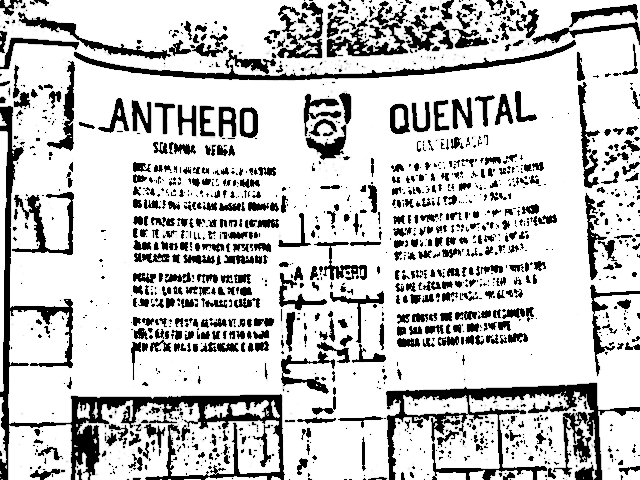
Let’s start with a bang.
It’s a few minutes before 8 o’clock at night, Campo São Francisco square, in the forgotten city of Ponta Delgada. It’s September 11th, 1891. A man sits down at a bench placed against the southern wall of the convent Nossa Senhora da Esperança (Convent of Our Lady of Hope). Above him, there’s an anchor on the wall with Esperança (Hope) written across it as if holding the world in place against a terrible inevitability. He looks ahead to the public square, the fort, and the ocean beyond it, drawing in the cool night air as his lungs fill with resignation. He lifts up his recently bought gun, puts the barrel in his mouth and shoots one time, and then another, finally succeeding in taking his own life. After the last gunshot, the night goes quiet again. The pale light of the moon shines down from the cross atop the church of São José, blessing the lifeless body as the gun smoke rises up like a soul trying to reach heaven, where the existential disquiet can rest at last.
What a wonderful way to start this guide to the city of Ponta Delgada, in São Miguel island. That lovely bit of story was about Antero de Quental (1842-1891), an Azorean writer, philosopher, journalist, and poet, who achieved the highest literary expression with his sonnets and philosophical discourse.
Before we go any further, let me explain how this series of guides will work. This text is not intended to be a traditional tourist guide—simply pointing out small tidbits of history about the island or its main cities, places to go, eat, and have fun. Instead, my goal is to provide a sort of narrative line, woven from weird Azorean people, strange events, or little-known histories or places that will guide the more traditional and expository content that you would expect from a local guide. Of course, all of this combined with a politically incorrect attitude. So don’t expect the clean-cut, “Everything is beautiful here” kind of guide. I’ll take you to the gutter of the Azorean soul so you can better appreciate us and each place of this small island. Having said this, let’s continue.
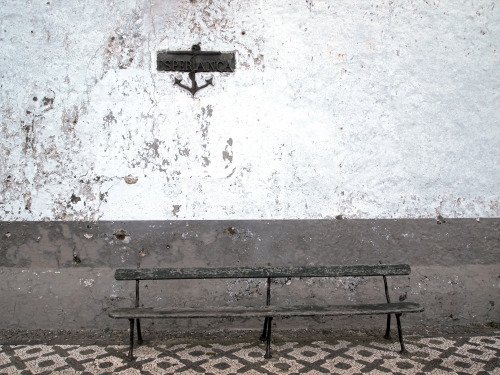
The bench where Antero de Quental committed suicide.
Antero had been dealing with severe depression before his suicide. He could have suffered from Bipolar Disorder has some have suggested. He lived in mainland Portugal, Vila do Conde, before returning to Ponta Delgada in 1891—a period he considered the best of his life. In his atlantic hometown, depressed, he went to one of the city’s plazas, Campo São Francisco, to put an end to a life that had crowned him as a symbol of a generation.
He passed by the historical plaza moments before the fatal shot, with his ravenous mind probably swirling in memories, in poetic verses, in letters, and controversies that he had been a part of. He was the central figure of a conflict between traditionalist poets and a younger, more liberal, intellectual generation. This would become known as the Questão Coimbrã (Coimbra Question). Him and his intellectual rebels—figures such as Teófilo Braga, Eça de Queirós, and Ramalho Ortigão—contested the literary aesthetic formalism of the day, resulting in a series of letters and pamphlets; attacks and counterattacks between Antero and his former teacher (and main voice of the traditionalist movement), António Feliciano de Castilho.
Sitting at that bench crowned with an anchor, he had a good view of Campo São Francisco, a place where, every year, people celebrate their devotion to Senhor Santo Cristo dos Milagres (Lord Holy Christ of the Miracles)—the island’s largest religious celebrations that begin on the first Sunday of Easter. This plaza was created in the 19th century, taking its name from a convent that existed next to it—Convento de São Francisco. Surrounding the square are a series of religious and military buildings: São José church in the west, the Nossa Senhora da Esperança convent in the north, and the São Brás fort in the south.
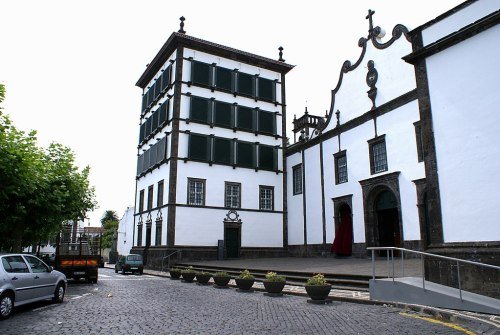
Nossa Senhora da Esperança convent and the sanctuary.
During the religious festivities of Santo Cristo, the plaza becomes the center of the city and, indeed, of the whole island with daily worship, processions, people circling the square on their knees to repay grants given by God, and traditional small bars where people can eat and drink. In 2013, the plaza suffered a major renovation that gave it its current form.
Five years before the Azorean writer’s death, in 1886, he had published his greatest poetic work, Sonetos Completos. He was a master at sonnets, hammering the words into verses of gracious beauty that, in the case of this opuscule, contained passages inspired by his life and symbolism. With his back against the wall of the Nossa Senhora da Esperança convent, Antero was evermore resolute in his final decision; even the centuries-old prayers that resonated around that place like a spiritual mist couldn’t possibly dissuade him. He would close his eyes and inhale the cool night air for a last time near the sanctuary where the statue of Santo Cristo rests yearlong, receiving requests for healing, good luck, and passionate devotion.
The beginning of the convent’s construction dates back to 1535. According to the Azorean historian Gaspar Frutuoso, in 1541, it received the first nuns from Caloura. With them also came the image of Senhor Santo Cristo dos Milagres. During the latter half of the 17th century, Madre Teresa da Anunciada, a nun at the convent, would begin the cult to the image of Santo Cristo, a tradition that continues to this day.
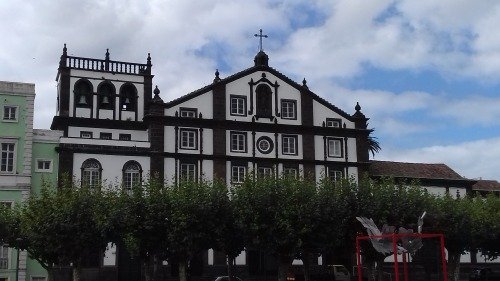
Church of São José.
In his youth, Antero was eager to escape the Catholic tradition of the island, rebelling against tradition, against the placid reverence of his Azorean family, against the history and religion that crystallized so much of the Azorean soul. Later in life, he would somewhat find a sense of spirituality, of the ethereal; that transcendental spark that would illuminate the abyss of his being where emptiness reigned supreme. To his right, a statue of an ancient saint looked down on him with stony eyes, solemnly, from atop São José church.
This church is the last remnant of an extinct convent dated from the 17th and 18th centuries. After the arrival of the Franciscan Friars to Ponta Delgada, in 1525, it took the place of a small church from the 16th century. However, it was only in 1709 that the building of the current church started, influenced by Mannerism and Baroque styles.
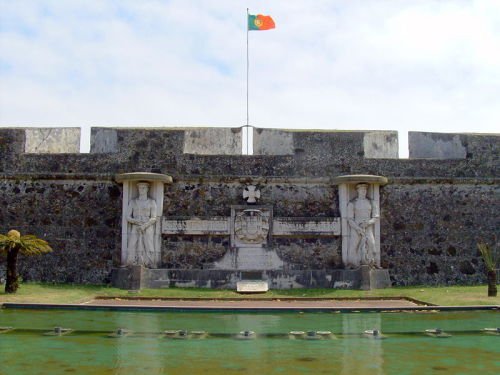
São Brás fort.
Antero de Quental held the gun against his mouth. Before closing his eyes, before the shot that would ravish his flesh and life, his eyes looked upon the Forte de São Brás (São Brás Fort), built in the 16th century and the last of several forts that once existed in Ponta Delgada. It is considered the most important example of military architecture of the 16th century and the islands’ strongest fort that protected the city against pirates and corsairs—once a common occurrence in this region of the Atlantic. Throughout the centuries, the fort suffered major renovations and today is home to the Military Museum of the Azores.
To this day, the fort still guards the city and the place where Antero chose to depart from this world, leaving his words has descendants—born out of his gloominess, growing into beautiful sentences that made love with the Portuguese language. As the great poet Fernando Pessoa said, “Properly speaking there has been no Portuguese literature before Antero de Quental; before that there has been either a preparation for a future literature, or foreign literature written in the Portuguese language.” For Antero de Quental, hope may have died under that ironic anchor, but for us it meant the rise of the tides of a new literary expression.
Congratulations @paulopacheco! You have completed the following achievement on the Steem blockchain and have been rewarded with new badge(s) :
Click here to view your Board of Honor
If you no longer want to receive notifications, reply to this comment with the word
STOPDo not miss the last post from @steemitboard:
Downvoting a post can decrease pending rewards and make it less visible. Common reasons:
Submit
Congratulations @paulopacheco! You received a personal award!
Click here to view your Board
Downvoting a post can decrease pending rewards and make it less visible. Common reasons:
Submit
Congratulations @paulopacheco! You received a personal award!
You can view your badges on your Steem Board and compare to others on the Steem Ranking
Vote for @Steemitboard as a witness to get one more award and increased upvotes!
Downvoting a post can decrease pending rewards and make it less visible. Common reasons:
Submit